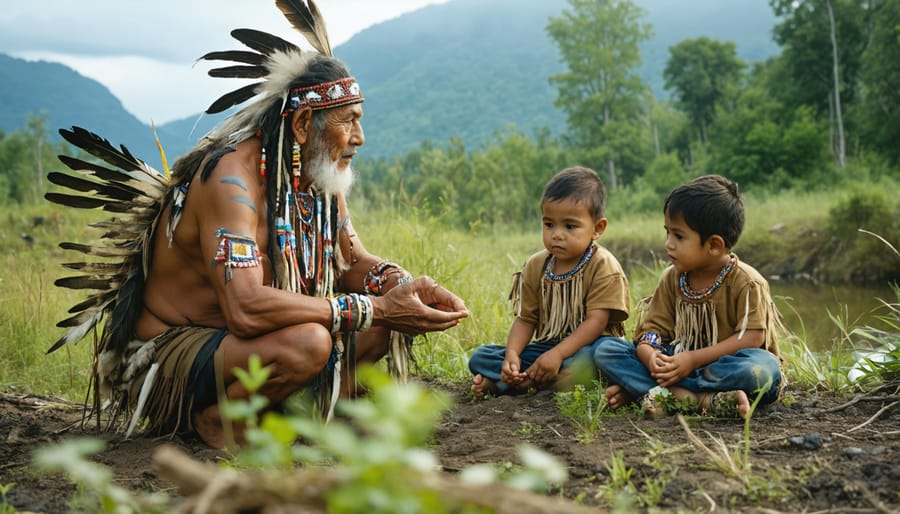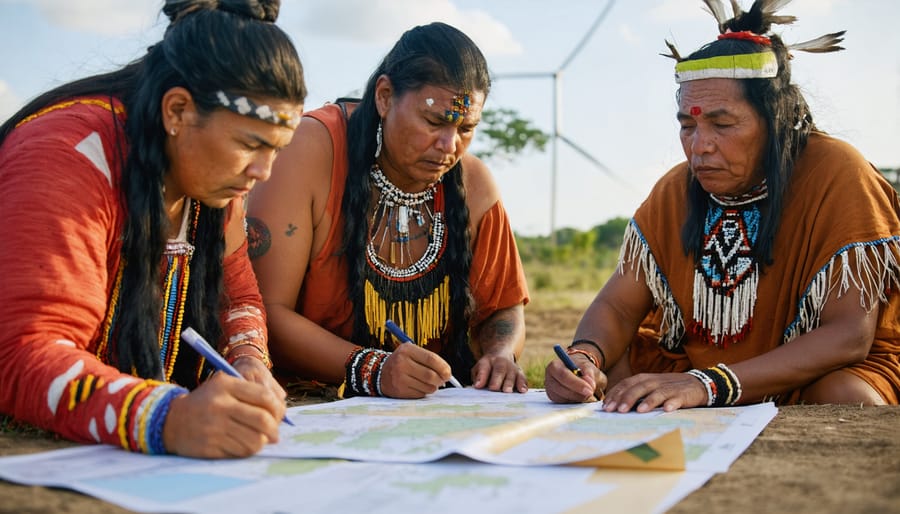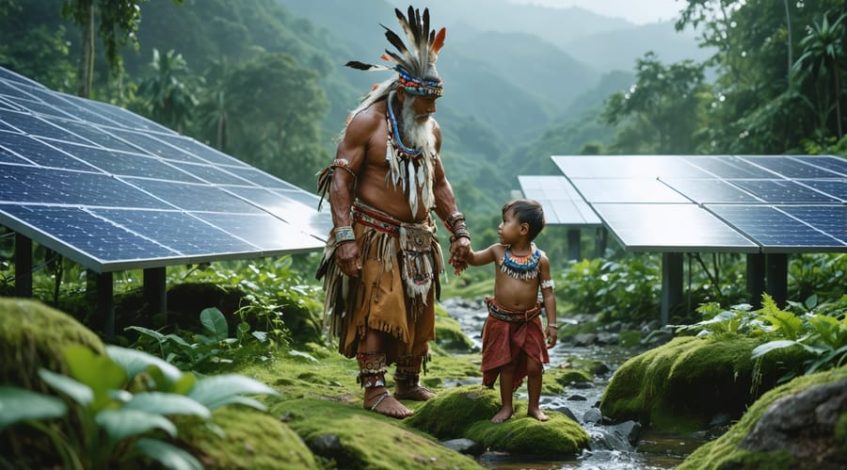Indigenous environmental justice represents a critical intersection of traditional ecological knowledge and modern sustainability challenges. As communities worldwide grapple with climate change and resource management, indigenous perspectives offer proven frameworks for environmental stewardship that have sustained ecosystems for millennia.
The integration of indigenous environmental principles into contemporary policy and practice isn’t merely about historical recognition—it’s about implementing effective, time-tested approaches to environmental protection. These methods, developed through generations of direct interaction with local ecosystems, provide practical solutions for current environmental challenges while addressing historical inequities in resource management and land use decisions.
Leading organizations and governments are increasingly recognizing that meaningful environmental justice requires active partnership with indigenous communities, incorporating their expertise in conservation strategies and sustainable development initiatives. This collaborative approach has demonstrated superior outcomes in biodiversity preservation, climate resilience, and sustainable resource management across diverse geographical contexts.
By combining traditional ecological knowledge with modern scientific methods, we can develop more effective and equitable environmental solutions. This integration creates opportunities for sustainable development that respects both environmental and cultural preservation while advancing economic opportunities for indigenous communities.
Traditional Indigenous Environmental Stewardship
Sacred Connection to Land and Resources
Indigenous peoples maintain a profound relationship with natural resources that extends beyond mere economic value. This worldview recognizes land and resources as living entities deserving of respect and reciprocal care. Traditional ecological knowledge, developed over generations, emphasizes sustainable resource management practices that balance human needs with environmental preservation.
In the context of modern energy development, indigenous perspectives offer valuable insights for sustainable project implementation. These communities traditionally practice cyclical resource use, where extraction is balanced with regeneration periods, ensuring long-term ecosystem health. This approach aligns with contemporary sustainability goals while adding deeper cultural and spiritual dimensions to resource management.
Many indigenous communities view themselves as stewards rather than owners of natural resources, emphasizing responsibility over exploitation. This perspective has proven particularly relevant in renewable energy development, where successful projects often incorporate traditional knowledge with modern technology. The resulting frameworks demonstrate how indigenous environmental values can enhance sustainable development while preserving cultural heritage and ecological integrity.
Such holistic approaches to resource management offer valuable lessons for modern energy projects, particularly in areas where traditional territories intersect with renewable energy potential.
Generational Knowledge and Sustainable Practices
Indigenous communities have long maintained sophisticated systems of traditional ecological knowledge that demonstrate remarkable effectiveness in sustainable resource management. These time-tested practices, developed over generations of careful observation and adaptation, offer valuable insights for modern environmental challenges. For example, indigenous fire management techniques in Australia have proven superior to conventional methods in preventing catastrophic bushfires while promoting biodiversity.
These traditional practices often integrate cyclical resource use patterns, ensuring sustainable yields while maintaining ecosystem health. The Three Sisters agricultural method, developed by Native American communities, exemplifies how intercropping can enhance soil fertility and crop yields without chemical inputs. Similarly, traditional water management systems in arid regions demonstrate sophisticated understanding of hydrological cycles and conservation techniques.
Modern environmental initiatives increasingly recognize the value of incorporating these ancestral practices into contemporary conservation strategies. This integration has led to successful outcomes in forest management, wildlife conservation, and sustainable agriculture programs worldwide, proving that indigenous knowledge systems can effectively complement scientific approaches to environmental stewardship.

Indigenous Communities Leading Solar Innovation
Tribal Solar Initiatives
Tribal nations across North America are emerging as leaders in renewable energy adoption, with solar initiatives showcasing the intersection of traditional values and modern sustainability practices. The Navajo Nation’s Kayenta Solar Project stands as a pioneering example, generating 55 megawatts of clean energy while providing employment opportunities for tribal members and reducing dependency on fossil fuels.
The Southern Ute Indian Tribe in Colorado has implemented a comprehensive solar strategy, installing photovoltaic systems on governmental buildings and residential properties. This initiative not only reduces energy costs but also serves as a model for tribal energy sovereignty and economic development.
In Arizona, the Gila River Indian Community has partnered with utility companies to develop a 68-megawatt solar installation, demonstrating how tribal lands can be utilized for renewable energy production while preserving cultural heritage. The project generates sufficient power for approximately 18,000 homes while providing steady revenue for community programs.
The Blue Lake Rancheria Tribe in California has created a sophisticated microgrid system incorporating solar power, which ensures energy security during emergencies and reduces annual carbon emissions by nearly 200 tons. This implementation has become a case study for resilient tribal infrastructure development.
These initiatives reflect a broader movement among indigenous communities to harmonize environmental stewardship with economic advancement. By incorporating traditional ecological knowledge into modern solar technologies, tribal nations are establishing sustainable frameworks that benefit both their communities and the environment. These projects also create valuable partnership opportunities between tribal governments, utility companies, and federal agencies, fostering long-term economic and environmental sustainability.

Community-Driven Energy Independence
Indigenous communities across North America are increasingly leading the transition to renewable energy, demonstrating how energy sovereignty can drive both environmental protection and economic development. The Navajo Nation’s significant investment in utility-scale solar projects exemplifies this movement, with their 55-megawatt Kayenta Solar facility creating local jobs while providing clean power to over 13,000 homes.
The Standing Rock Sioux Tribe has implemented a comprehensive renewable energy strategy, combining solar installations with workforce development programs. Their initiative not only reduces dependency on external power sources but also creates sustainable employment opportunities for community members. This model of energy independence aligns traditional ecological knowledge with modern sustainable technologies.
Several First Nations communities in Canada have successfully developed micro-grid systems powered by solar and wind energy, effectively reducing their reliance on diesel generators. The T’Sou-ke First Nation in British Columbia has become entirely solar-powered, operating two solar installations that meet their community’s needs while generating surplus energy for additional revenue.
These initiatives demonstrate how indigenous-led energy projects can:
– Strengthen community self-determination
– Generate sustainable income streams
– Preserve traditional lands and resources
– Create local employment opportunities
– Reduce carbon emissions
– Build resilience against climate change
The success of these projects has created a blueprint for other communities seeking to achieve energy independence while maintaining cultural values and environmental stewardship. This approach to energy development represents a significant shift toward community-controlled, sustainable power generation that benefits both people and the environment.
Integrating Indigenous Knowledge in Modern Solar Development
Land Use and Sacred Site Considerations
Responsible solar development requires careful consideration of indigenous land rights and cultural heritage. Developers must engage in meaningful consultation with indigenous communities early in the project planning phase to identify and protect areas of cultural significance. This includes conducting thorough cultural resource assessments and implementing sacred site preservation protocols that align with traditional values and practices.
Successful projects typically incorporate buffer zones around sacred areas, establish clear access protocols for indigenous ceremonial practices, and develop long-term management plans in partnership with tribal authorities. Environmental impact assessments should extend beyond conventional ecological factors to include indigenous perspectives on land stewardship and spiritual connections to the landscape.
Key considerations include:
– Documenting traditional land use patterns
– Mapping cultural heritage sites
– Establishing formal agreements for site access
– Creating monitoring programs with indigenous participation
– Developing relocation protocols for artifacts
– Implementing indigenous employment opportunities
By integrating these considerations into project planning, developers can create sustainable energy solutions that respect indigenous rights while advancing clean energy goals. This approach not only ensures regulatory compliance but also builds lasting partnerships with indigenous communities, creating a foundation for environmentally just development practices.

Collaborative Project Planning
Successful collaboration between solar developers and indigenous communities requires a structured framework that respects traditional knowledge while advancing clean energy goals. The foundation of this partnership begins with early engagement and meaningful consultation, ideally during the initial project planning phases.
A comprehensive collaborative framework should include four key elements: transparent communication channels, shared decision-making processes, fair benefit-sharing agreements, and ongoing community involvement throughout the project lifecycle. Solar developers must establish dedicated liaison teams who work directly with tribal leaders and community representatives to ensure cultural values and environmental concerns are adequately addressed.
The planning process should incorporate traditional ecological knowledge alongside modern environmental assessments. This dual approach often yields more comprehensive understanding of local ecosystems and potential project impacts. Developers should allocate sufficient time and resources for indigenous communities to conduct their own environmental and cultural impact assessments.
Formal agreements should clearly outline roles, responsibilities, and benefits. These may include provisions for local job creation, skills training programs, revenue-sharing mechanisms, and commitments to protect sacred sites or culturally significant areas. Regular monitoring and reporting mechanisms should be established to track progress and maintain accountability.
Success stories from Australia and Canada demonstrate how this collaborative approach can lead to mutually beneficial outcomes, with indigenous communities becoming active stakeholders in renewable energy projects while maintaining their role as environmental stewards.
Environmental Impact Assessment
The integration of Indigenous Traditional Ecological Knowledge (TEK) into modern environmental impact assessment processes represents a significant advancement in project evaluation methodologies. This approach combines centuries-old understanding of local ecosystems with contemporary scientific methods, resulting in more comprehensive and culturally sensitive evaluations.
Traditional knowledge holders contribute valuable insights about seasonal patterns, wildlife behavior, and ecosystem relationships that might not be apparent through conventional scientific observation alone. For example, the Nuu-chah-nulth First Nations in British Columbia have successfully integrated their traditional knowledge into coastal resource management, leading to more sustainable fishing practices and improved marine habitat protection.
Project developers who incorporate Indigenous perspectives often report more accurate long-term environmental forecasting and better stakeholder relationships. This collaborative approach has proven particularly effective in renewable energy projects, where Indigenous communities’ understanding of local wind patterns, solar exposure, and seasonal variations has enhanced site selection and project design.
Key benefits of this integrated approach include:
– Enhanced identification of culturally significant areas
– Better understanding of local ecosystem dynamics
– Improved prediction of cumulative environmental effects
– Stronger community engagement and support
– More sustainable long-term outcomes
This holistic evaluation method ensures that development projects not only meet regulatory requirements but also align with traditional stewardship principles and community values.
Future of Indigenous-Led Sustainable Energy
Indigenous communities are increasingly taking the lead in sustainable energy development, establishing innovative models that combine traditional ecological knowledge with modern technology. Several First Nations communities across North America have successfully implemented large-scale solar and wind projects, demonstrating the viability of indigenous-led renewable energy initiatives.
The future of indigenous-led sustainable energy presents significant opportunities for economic development and environmental stewardship. Many communities are developing hybrid systems that integrate multiple renewable sources, creating resilient microgrids that ensure energy independence while preserving traditional lands. These projects often serve as blueprints for other communities seeking to transition away from fossil fuel dependency.
Recent partnerships between indigenous groups and clean energy developers have resulted in groundbreaking projects that prioritize both environmental protection and community benefits. For example, the T’Sou-ke First Nation’s solar initiative in British Columbia not only powers their community but also provides training and employment opportunities for community members.
Looking ahead, indigenous-led energy projects are expected to play a crucial role in meeting national renewable energy targets. Many communities are developing comprehensive energy strategies that incorporate traditional knowledge about land stewardship with cutting-edge sustainable technologies. These initiatives often include training programs for indigenous youth, ensuring long-term community capacity building.
The emergence of innovative financing models specifically designed for indigenous communities is facilitating broader access to renewable energy development. Government agencies and private sector partners are increasingly recognizing the value of indigenous leadership in sustainable energy projects, leading to more equitable partnerships and investment opportunities.
This shift towards indigenous-led energy development represents a significant opportunity for achieving both environmental justice and economic sovereignty while contributing to global climate change mitigation efforts.
Indigenous environmental justice represents a crucial paradigm shift in how we approach sustainable development and resource management. By integrating traditional ecological knowledge with modern environmental practices, stakeholders can create more equitable and effective solutions for our shared environmental challenges. Industry leaders must recognize that meaningful partnerships with indigenous communities not only fulfill ethical obligations but also unlock valuable insights for sustainable resource management.
Moving forward, businesses and organizations should prioritize indigenous consultation from project inception, establish clear benefit-sharing agreements, and create lasting partnerships that respect traditional knowledge systems. Government officials and facility managers can lead by example by implementing policies that protect indigenous rights while advancing environmental goals. This includes developing transparent consultation processes, providing appropriate compensation for resource use, and ensuring indigenous communities have decision-making power in projects affecting their territories.
The path to environmental justice requires commitment from all stakeholders. By embracing indigenous perspectives and traditional knowledge, we can build a more sustainable and equitable future while addressing critical environmental challenges. The time for action is now – let us work together to create positive change that benefits both our planet and its people.

